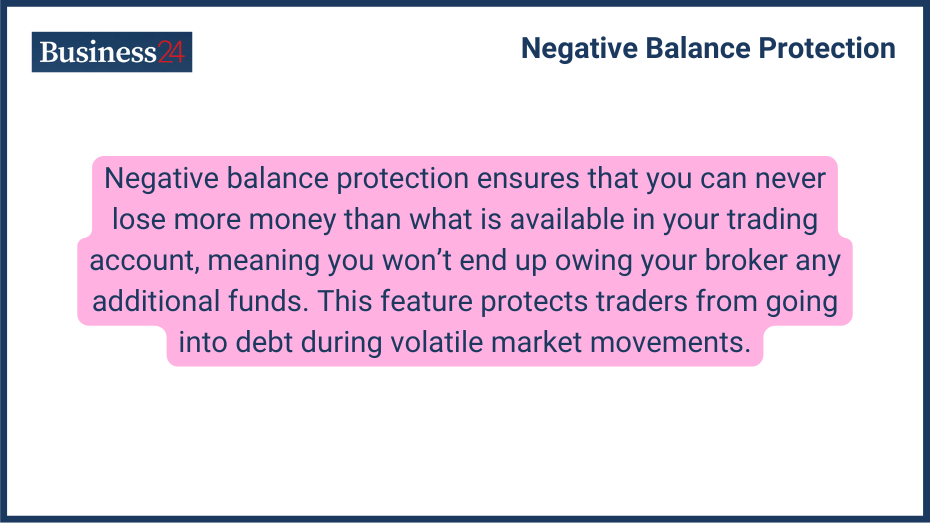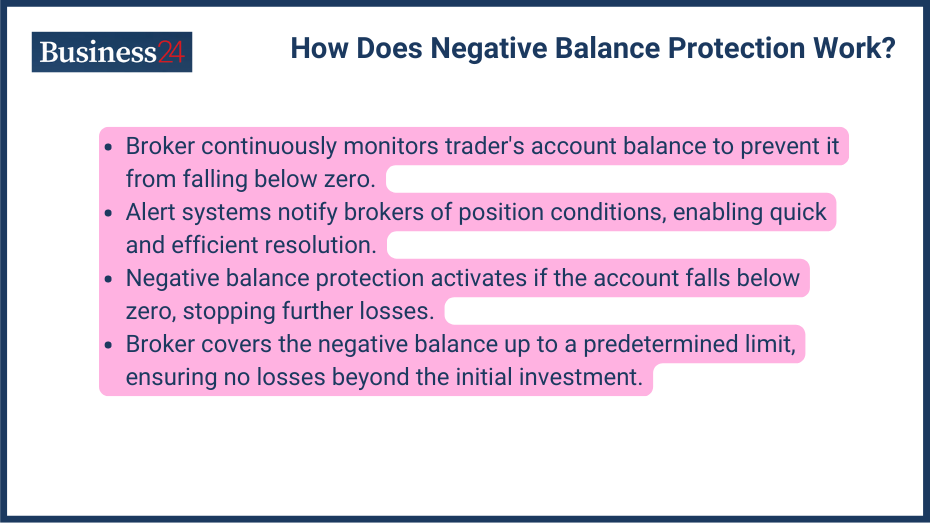
Negative balance protection ensures that you can never lose more money than what is available in your trading account, meaning you won’t owe your broker any additional funds. This feature protects traders from going into debt during volatile market movements.
Sometimes, due to high volatility events, traders incur high swings in their positions, and sometimes, losses increase to the extent that they exceed their initial investment. Some brokers offer negative balance protection to protect against such situations. With this feature, if a trader’s account balance falls below zero due to losses, the broker will cover the negative balance up to a certain limit. If a broker doesn’t provide debt, he will close the position at breakeven before it goes into any loss.
Negative balance protection is a crucial safety net for retail traders. It protects against catastrophic losses, ensuring traders cannot lose more than their initial investment.
Why Is It Important for Retail Traders?
Negative balance protection is important for retail traders for several reasons:
- Limiting financial risk: Negative balance protection can help limit financial risk and protect traders from catastrophic losses by preventing them from incurring losses that exceed their initial investment. It is a crucial safety net for retail traders.
- Providing peace of mind: Knowing that their losses are capped can give traders peace of mind and allow them to focus on their trading strategies without worrying about financial ruin. This is particularly important for new traders who may be more susceptible to fear and anxiety.
- Encouraging responsible trading: Negative balance protection can encourage traders to trade more responsibly by reducing the fear of significant losses. Helping prevent impulsive trading and emotional decision-making can lead to costly mistakes.
How Does Negative Balance Protection Work?

Mechanism of Protecting Against Negative Balances
The exact mechanism of negative balance protection can vary depending on the broker, but generally, it involves the following steps:
Step 1: The broker monitors the trader’s account balance to ensure it does not fall below zero. Alert systems tell the broker about a position’s conditions, and brokers need to monitor them continuously so they can be resolved quickly and efficiently.
Step 2: The broker’s negative balance protection mechanism is triggered if the account balance falls below zero. This means the broker will take steps to prevent the trader from further losses.
Step 3: The broker covers the negative balance up to a predetermined limit. The broker will cover the negative balance up to a predetermined limit, ensuring that the trader does not incur any losses beyond their initial investment.
Examples of Broker Implementation
Here are some examples of how different brokers implement negative balance protection:
- Automatic margin calls: Some brokers may implement automatic margin calls to prevent accounts from falling below zero. If a trader’s account balance falls below a certain level, the broker will automatically sell positions to return the balance safely.
- Direct funding: Other brokers may directly fund the account to cover the negative balance. The broker will use its funds to return the account balance to zero. This can be particularly helpful in cases where the trader cannot meet a margin call or if the broker believes that the trader is not at fault for the negative balance.
Benefits of Negative Balance Protection
Here are some of the benefits of negative balance protection:
- Limiting Losses: The most significant benefit of negative balance protection is that it limits traders’ losses to their initial investment. This means that traders can only lose what they have deposited into their accounts, even if their trades are unsuccessful.
- Protecting Traders in Volatile Markets: Negative balance protection can be particularly beneficial in volatile markets, where prices fluctuate rapidly and losses accumulate quickly. By limiting losses, negative balance protection can help protect traders from market volatility’s devastating effects. This can be especially important during economic uncertainty or market turmoil when prices can experience sharp declines.
Who Provides Negative Balance Protection?
Many online brokers offer negative balance protection as a standard feature. However, it is important to check with your broker to confirm if they offer this protection and to understand any limitations or conditions that may apply. It is also important to compare the terms and conditions of different brokers to find the best deal for your needs.
Regulatory Requirements for Negative Balance Protection
In some jurisdictions, brokers are required by law to offer negative balance protection to their clients. This is typically the case in countries with strict financial regulations, such as the United States and the European Union. These regulations are in place to protect retail traders and ensure that they are not exposed to excessive risk.
Risks and Considerations
Risk and consideration associated with negative balance protection:
- Limitations of the Protection: While negative balance protection can be a valuable tool for traders, it is important to understand its limitations. Some brokers may have limits on the amount of negative balance that they will cover, and certain types of trades or market conditions may not be covered by the protection. It is important to carefully review the terms and conditions of the broker’s negative balance protection policy to understand any applicable limitations.
- Potential for Moral Hazard: Negative balance protection can create a moral hazard, as traders may be more willing to take on excessive risk, knowing their losses are capped. This can lead to irresponsible trading and increase the broker’s risk of losses.
- Impact on Broker Costs: Providing negative balance protection can increase brokers’ costs, which can lead to higher trading fees or other charges for clients.
Conclusion
Negative balance protection is a valuable feature that can help limit financial risk and protect traders from catastrophic losses. While it does not guarantee profits, it can provide peace of mind and encourage responsible trading. It is important for traders to understand the limitations of negative balance protection and choose a broker offering this feature. By choosing a broker that offers negative balance protection, traders can reduce their risk exposure and focus on their trading strategies without worrying about financial ruin.
Disclaimer
eToro is a multi-asset platform which offers both investing in stocks and cryptoassets, as well as trading CFDs.
Please note that CFDs are complex instruments and come with a high risk of losing money rapidly due to leverage. 51% of retail investor accounts lose money when trading CFDs with this provider. You should consider whether you understand how CFDs work, and whether you can afford to take the high risk of losing your money
This communication is intended for information and educational purposes only and should not be considered investment advice or investment recommendation. Past performance is not an indication of future results.
Copy Trading does not amount to investment advice. The value of your investments may go up or down. Your capital is at risk.
Don’t invest unless you’re prepared to lose all the money you invest. This is a high-risk investment and you should not expect to be protected if something goes wrong. Take 2 mins to learn more
eToro USA LLC does not offer CFDs and makes no representation and assumes no liability as to the accuracy or completeness of the content of this publication, which has been prepared by our partner utilizing publicly available non-entity specific information about eToro.
